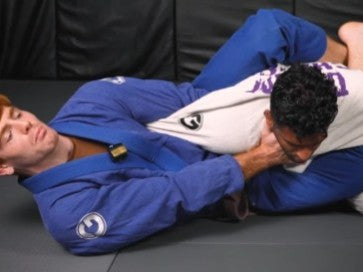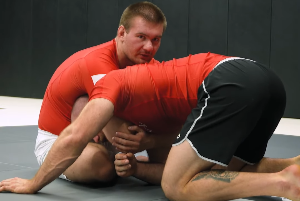When then-Senator John McCain tried to get mixed martial arts (MMA) banned in the United States in 1996, he referred to it as “human cockfighting.” At the time, MMA fights were not nearly as regulated as they are today. In fact, the very first Ultimate Fighting Championship (UFC) event held on November 12, 1993, was billed as a no-holds-barred competition with no rules to determine the most effective fighting style. When it came down to it, though, even that first event banned two moves: biting and eye gouging.
Fast forward to today, and the UFC follows the Unified Rules of MMA, which includes a greatly expanded list of illegal moves to help ensure the safety of fighters, to discourage unsportsmanlike conduct, and to keep fights fair. Developed by the Association of Boxing Commissions and Combative Sports (ABC), the Unified Rules of MMA ban the following moves:
1. Headbutting
Although headbutts (using your head as a striking instrument) are illegal in almost all combat sports, there are a few notable exceptions, including Lethwei, a full contact combat sport in Myanmar; combat Sambo; Vale Tudo; and Kudo.
Since headbutts can sometimes occur accidentally during a fight, referees are responsible for determining whether the headbutt is a foul, which results in a warning or a point deduction, or whether the headbutt is a flagrant foul that results in immediate disqualification.
At UFC Vegas 92 in May of 2024, Piera Rodriguez received a warning from referee Mark Smith after headbutting her opponent, Ariane Carnelossi, while in Carnelossi’s guard in the second round. Rodriguez’s response? Another headbutt seconds later, which got her disqualified.
2. Eye Gouging
Eye gouging (using fingers, chin, or elbow) is illegal to protect the safety of fighters. If you can’t see your opponent, you can’t fight or defend yourself intelligently. Also, if you’ve ever seen the results of an eye poke or eye gouge, they’re pretty horrific and can result in lasting eye damage.
Because UFC fighters use open-fingered gloves, however, unintentional eye pokes occur on a fairly regular basis. If the referee catches it, the affected fighter will be given five minutes to recover, and the offender will usually be given a warning. If they’ve already received a warning, they might have a point deducted. In cases where the affected fighter cannot continue, the fight might end in a no contest or disqualification.
Sometimes the referee doesn’t see it, and the results can be controversial. Take the recent fight between former champ Chris Weidman and Bruno Silva, for example. Originally, Weidman was awarded the win via technical knockout (TKO) but after reviewing the footage and seeing not one but two vicious but accidental eye pokes, the New Jersey State Athletic Control Board decided to turn to the scorecards instead. Weidman was ahead on points, so the ruling was changed to a decision win.
Eye gouging is such a prevalent problem, in fact, that having fingers outstretched towards an opponent’s face or eyes is actually prohibited in the UFC as well but is much more dependent on a referee’s judgment and more difficult to regulate.
3. Fish Hooking
Fighters are not allowed to put either their finger(s) or hand(s) into the mouth, nostrils, or ear of their opponent in order to pull the head away from the body’s center line or rip or tear the skin. Although you don’t see fish hooking as often as some of the other moves on the list, it does happen occasionally like at UFC 281 when Michael Chandler clearly fish hooked Dustin Poirier.
4. Biting or Spitting at an Opponent
It should go without saying that you shouldn’t ever bite your opponent. Apparently, Igor Severino didn’t get the memo before his debut fight against Andre Lima. Not only was Severino disqualified but he was also immediately released from the UFC.
5. Piledriver
Originally made popular in professional wrestling, spiking your opponent to the mat on his head or neck (also known as a piledriver) is not allowed in the UFC because it could lead to serious injuries, including paralysis. One exception to this rule is if you are defending against a submission attempt and can elevate your opponent, you are allowed to bring your opponent to the mat in any way you want, including headfirst, since you are not in control of your opponent’s body and they could let go of the submission to avoid the piledriver.
For example, on Dana White’s Contenders series in 2022, UFC hopeful Armian Gogoladze attempted a reverse triangle on Darrius Flowers. To escape, Flowers stood up and then dropped to his knees, slamming Gogoladze’s head to the mat. Although he initially held on, Gogoladze eventually signaled to the referee and tapped his opponent, indicating that he could not continue due to a shoulder injury from the impact. The official decision was ruled a TKO slam, and Flowers earned a UFC contract.
The MASSIVE slam from Darrius Flowers leads to the tap & the first round finish 💥 #DWCS pic.twitter.com/VtXokkK3zc
— UFC (@ufc) August 24, 2022
6. Downward Pointing (or 12-6) Elbows
Although elbows are an important weapon in MMA, fighters have to be careful not to use downward pointing elbow strikes, which are illegal in the UFC. There remains some confusion at times about what constitutes a 12-6 elbow versus legal elbow strikes, but basically fighters cannot raise their elbow straight up (to the 12 o’clock position) and then bring it straight down (to the 6 o’clock position), using the tip of the elbow to strike their opponent. They can arc or angle their arms as long as the strike is not aimed at the spine or the back of the head (see below), but it is often at the referees’ discretion when deciding whether an elbow strike is illegal.
As with other fouls on this list, a referee might give a warning, take away a point, or disqualify a fighter if he considers the foul flagrant enough or the fighter has ignored previous warnings.
One of the most famous examples of 12-6 elbows came when Jon Jones faced off against Matt Hamill in the finale of The Ultimate Fighter 10 in 2009. Jon Jones dominated the fight, eventually taking Hamill down toward the end of the first round and mounting him before raining down damaging ground and pound, including some vicious elbows. Referee Steve Mazzagatti deemed one of those elbow strikes to be a 12-6 elbow, stopped the fight, and disqualified Jones, handing him his only career loss to date.
7. Strikes to the Spine or Back of the Head
Sometimes called rabbit punches, strikes to the back of the head or base of the skull/top of the spine are illegal in all major combat sports, including boxing, because they could result in significant damage or injuries to the brain, brain stem, and spinal cord.
During MMA bouts, fighters sometimes inadvertently hit the back of their opponent’s head in clinch situations, when their opponent is moving to defend against ground and pound, or in the course of throwing, ducking, and defending against punches. While these types of strikes are usually unintentional and elicit a warning from the referee, due to the seriousness of the potential consequences, fighters are sometimes disqualified.
Conor McGregor’s TKO win over Dustin Poirer at UFC 178 is an example of fairly blatant strikes to the back of the head that referee Herb Dean either didn't see or didn't call as fouls. Some have argued that the initial strike that knocked Poirer to the ground was to the back of the head and should have been illegal (as well as some of the follow-up strikes McGregor landed on Poirer while he was turtled on the ground). It's possible that Dean didn't call the first one because Poirer was ducking into the punch and didn't call the others because they wouldn't have changed the outcome of the fight. Either way, Herb Dean never called the fouls, and McGregor was declared the winner.
8. Knees or Kicks to the Head of a Grounded Opponent
If you were a fan of the PRIDE Fighting Championships in the late 90s and early 2000s, you’re probably familiar with soccer kicks where a standing or semi-standing fighter would deliver devastating kicks to any part of an opponent (but often the head) who was either completely down on the mat, kneeling, or rising. Fighters like Mauricio “Shogun” Rua and Wanderlei Silva famously used kicks and stomps (which are also illegal in the UFC) to great advantage.
Although fighters are not allowed to throw a knee or kick to the head of a grounded opponent in the UFC, they can knee other parts of a downed opponent.
Under the current definition, an opponent is considered “grounded” if anything other than the soles of their feet is bearing weight. Some fighters have been known to take advantage of the rule by simply placing a hand or even a finger down on the mat while in the clinch to avoid being kneed in the head.
The definition of a grounded opponent has gone through several changes over the years, and state athletic commissions have interpreted it differently, leaving fighters and referees scrambling to comply appropriately, depending on the location of the fight.
As of January 2024, the ABC is currently considering changes to the definition of “grounded” yet again to instead refer to any part of a fighter’s body besides their hands or feet coming in contact with the mat. A fighter would need to put down a knee, forearm, their back, etc. rather than just a finger or hand to be considered grounded. This distinction is more representative of situations that occur in fights while still protecting fighters, which is the purpose behind the rule.
Even under the new definition, Petr Yan’s illegal knee against Aljamain Sterling that cost him the bantamweight belt at UFC 259 in 2021 would still be illegal since Sterling’s knee was down.
9. Throat Strikes or Grabbing the Trachea
Fighters are not allowed to throw directed strikes to the throat or gouge a finger or thumb into the neck or trachea to try to submit their opponent. However, during stand-up exchanges, if a thrown strike (including a kick) lands in the throat area, it is considered legal.
Below are some examples of how devastating throat strikes, whether intentional or not, can be.
10. Groin Strikes or Low Blows
The Unified Rules of MMA prohibit any attack to the groin area. That means no kicking, striking, grabbing, pinching, or twisting.
Inadvertent low blows do occur, of course, especially for fighters who specialize in muay thai, kickboxing, or leg kicks. Usually, the referee will call time and give the affected fighter five minutes to recover.
At UFC 294, Victor Henry vs Javid Basharat ended in a No Contest ruling when Henry suffered an unintentional groin strike that sent him to the hospital.
Javid Basharat vs. Victor Henry ends in a No Contest due to an unintentional low blow#UFC294pic.twitter.com/kccrnrMhyt
— COMBAT SPORTS TODAY (@CSTodayNews) October 21, 2023
11. Small Joint Manipulation
Elbows, knees, wrists, ankles, and shoulders are considered large joints while fingers and toes are small joints. Fighters can grab the majority of fingers and/or toes at once but cannot twist, bend back, or pull on only one or two small joints at once.
Frank Mir famously has the only toe hold submission victory in UFC history when he got the tap from Tank Abbott at UFC 41 in 2003.
12. Hair Pulling
Interestingly enough, not only is pulling your opponent’s hair illegal, but fighters with long hair are also prohibited from using their own hair as a tool to hold or choke their opponent. The origins of the ban on hair pulling might well go back to UFC 3 when Royce Gracie grabbed onto Kimo Leopoldo’s ponytail to help him retain guard and then hold Leopoldo in place while he punched him from the bottom before eventually pulling the ponytail out.
13. Other Fouls
Although not necessarily MMA techniques or moves per se, there are several other prohibited actions according to the Unified Rules of MMA, including:
- Holding an opponent’s gloves or shorts
- Clawing, pinching, or twisting your opponent’s skin
- Non-engagement or timidity (e.g., refusing to make contact with your opponent, running away, faking injury, intentionally or repeatedly removing and dropping your mouth guard)
- Disregarding referee’s instructions
- Gripping the fence with fingers or toes
- Throwing an opponent out of the fighting area
- Putting fingers into cuts, lacerations, or any orifice (not just eye gouging and fish hooking)
- Attacking an opponent during a break, after the bell has sounded, or when an opponent is under a referee’s care
- Using abusive language inside the fighting area
- Engaging in any unsportsmanlike conduct that results in injury to your opponent
- Allowing your corner or seconds to interfere by distracting the referee or disrupting the fight to give you an unfair advantage over your opponent
Only referees can assess fouls and determine whether a warning, point deduction, or disqualification is appropriate. If a referee does not see or call a foul, judges are not allowed to make their own assessments or factor the potential foul into their scoring of the fight.
No referee or system is perfect. There are plenty of examples of missed fouls that changed the course of a fight, inconsistent referee calls where appropriate warnings were not given prior to a disqualification, early or late stoppages to fights, and more. However, having agreed-upon rules when it comes to illegal moves has certainly lent a greater degree of credibility and legitimacy to MMA and the UFC.
There does remain some disagreement within the MMA community about certain moves that are prohibited in the UFC but not other combat sports or fighting organizations (e.g., soccer kicks are allowed in the Rizin Fighting Federation in Japan, shootfighting, and vale tudo; throat strikes are acceptable in muay thai, etc.). It’s worth noting that the ABC continues to discuss and modify the rules as needed. In the end, though, increasing the safety of fighters and protecting the fairness of fights are goals that everyone agrees on.



